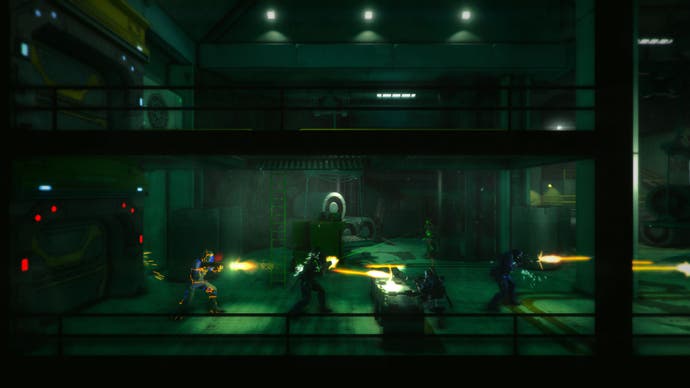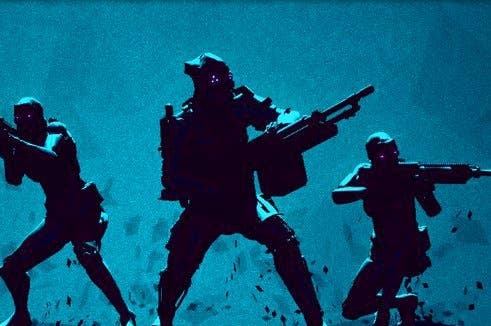Life after Crackdown: the many possibilities of Hollowpoint
Depth charge.
While it's generally a good idea to get a new perspective on things whenever you can, Crackdown 2 developer Ruffian Games has taken this quite literally with Hollowpoint. Stepping into a presentation at Paradox's annual convention, I'm prepared for a procedurally-generated platform shooter, and that's enough to pique my interest already. What I'm not prepared for is enemies charging from the scenery itself, bursting out of the background as if they're going to leap through the screen.
It's a slightly clumsy term, but Ruffian's creative director Billy Thomson calls Hollowpoint as a "2.5D game" and I can't think of a better way to describe it myself. At first, it looks and plays like a platformer. The player has control over two of those dimensions, sending their futuristic operatives dashing left and right through industrial environments, leaping onto gantries or ducking behind the inevitable and multitudinous crates. The third dimension is reserved for their opponents and while there is some face-to-face combat when (or if) enemies close in, much of the action comes from firing not left and right, but forward, inward. Hollowpoint almost turns from a platformer to a cover shooter and its detailed, busy backgrounds are quickly populated by drones, robots and soldiers.
I say "almost" because those two dimensions still rule the day, operatives moving from cover to cover and making use of previously irrelevant scenery to protect themselves from this new direction. The impression is that you're firing downrange, that the level has transformed into a shooting gallery, but a very angry one that gives as good as it gets.
It's unusual and a little disconcerting, not because it isn't well-executed, but because the danger comes from an unexpected quarter, bursting right out of the environment. I don't know if it's Ruffian's intention, but watching this happen again and again in their hands-off demo keeps me on edge. It removes a sense of the predictable, a sense of safety.

Hollowpoint is set in a post-national future, where gigantic corporations wield power and conduct covert wars against one another using teams of high-tech operatives, operatives kitted out in that particular kind of future-chic camo that is somehow always able to remain as stylish as it is functional. The specifics and even colours of those outfits is up to you, and here's where the Paradox connection comes in. The Swedish publisher is a particular fan of games steeped in detail and Hollowpoint's operatives are persistent characters who will undertake many missions, gaining skills and experience as you gradually mould them into highly-trained specialists. Missions are just jobs, it's your operatives' careers that are the bigger picture.
"The whole game's based around players building up these squads of operatives," explains Thomson, highlighting the individual stats of each soldier, even their expertise with certain weapon types. Those weapons themselves have almost as much personality as their users.
"Every single weapon, even every single stat on every single weapon is different," says Thomson. "They've all got their positives and negatives. They'll even all kick in slightly different ways. Pistols will kick in a certain direction, assault rifles will kick in another direction. Heavy machineguns will just kick all over the place." In time, and while scurrying off down whatever branches of the enormous skill tree you send them, operatives will master certain weapons - though at the expense of others. It all looks extremely granular.
Whoever you choose to be and whatever you choose to wield (even pink sniper rifles are acceptable in this dystopian future), Ruffian doesn't want you going it alone. While players only have control of one operative at a time, swapping others in and out as necessary, they're encouraged to bring friends. Ruffian want players to enjoy Hollowpoint co-operatively, taking on contracts with up to three other friends online, buddying up to provide covering fire or enjoy each other's combat buffs. That, and trying to handle whatever comes next.

Hollowpoint's contracts, its missions, are not only procedurally generated levels ("Imagine them as bits of Lego, but each piece of Lego has multiple variations... Our technical lead says there's 65,000 variations," says Thomson, offhand), they're also dynamic. They evolve as you play, new objectives appearing on the fly and even responding to player behaviour.
Perhaps most surprising was Thomson's mention of "asset packs" and the in-game currency. Players will earn currency as they play and can use it to buy items both practical and cosmetic, such as custom armour, some of which will be rare and no doubt much coveted. However, while there's every opportunity for this to be (here comes that word) monetized, Thompson says this isn't on the team's radar right now. The in-game currency remains in-game and, while players can trade between themselves to try and grab the gear they desire, reaching for their wallets isn't going to make any difference. Surprising, but also refreshing.
Unfortunately, Ruffian's demonstration is a hands-off experience and I'm merely watching as just two out of a possible four operatives fight their way through a near-future warehouse in a post-government world. It's compelling to see a giant, helicopter-like boss surge out of the background to attack, or to see enemy drones deploy shields that cover incoming soldiers, but it's impossible to tell if every procedural, dynamic mission will play out quite this well. Thomson admits that trying to squash bugs or fine-tune the game can sometimes be difficult when each mission plays out differently and can't easily be replayed for re-testing. He also adds that the operatives being used in the playthrough are "over-levelled" for the contract they've taken. For them, this mission is a walk in the park and they can't help but look cool.
Nevertheless, it's an interesting premise. The training and management of a team of expert operatives presents all sorts of possibilities for customisation and tweaking. Combined with an enormous number of levels and Thomson's assertion that "Paradox want to keep adding more content over time," typical of the publisher's business model, Hollowpoint could boast some serious longevity.

